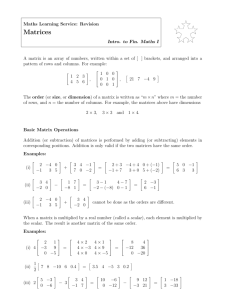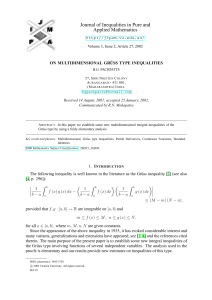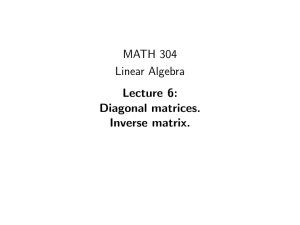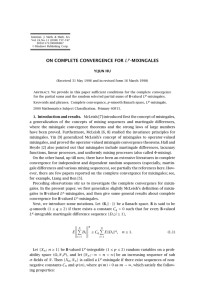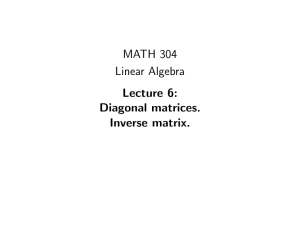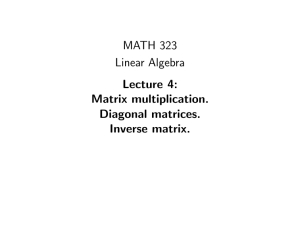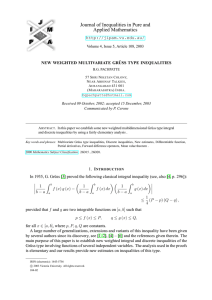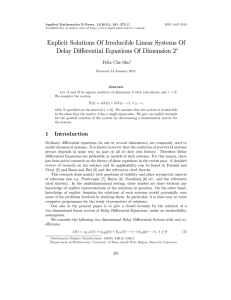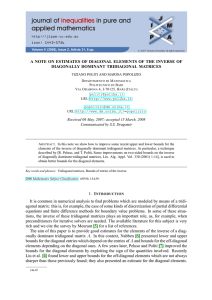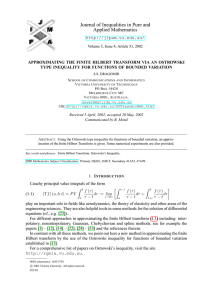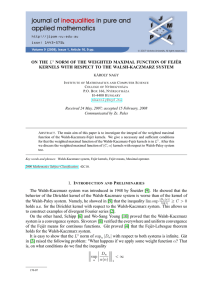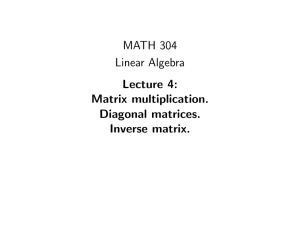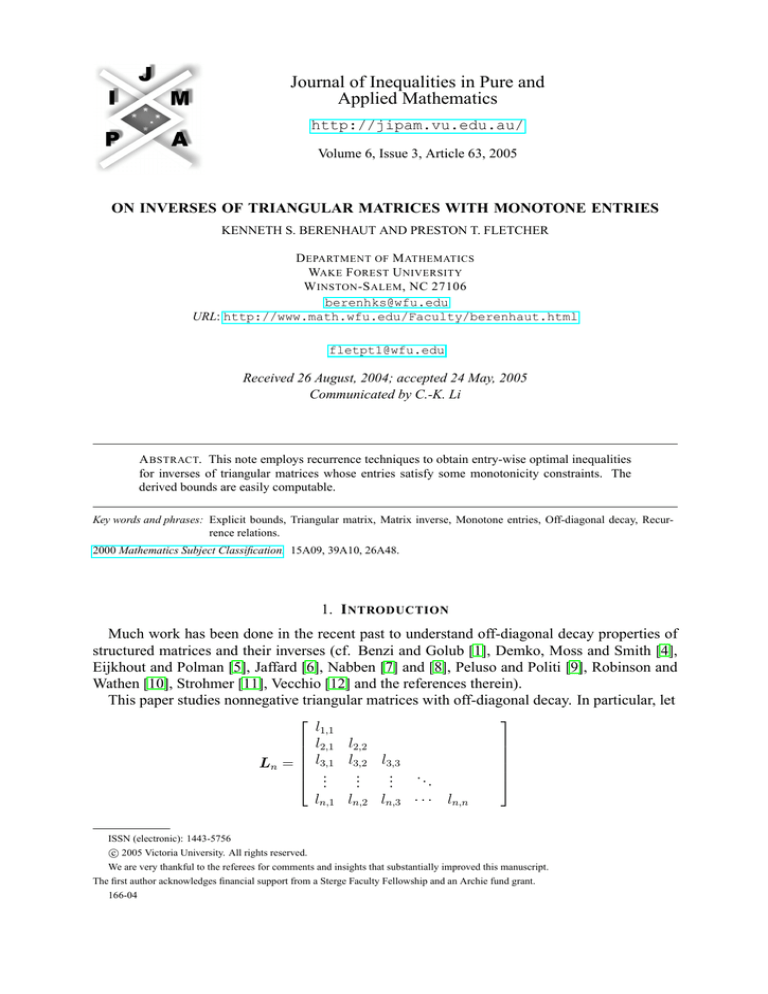
Journal of Inequalities in Pure and
Applied Mathematics
http://jipam.vu.edu.au/
Volume 6, Issue 3, Article 63, 2005
ON INVERSES OF TRIANGULAR MATRICES WITH MONOTONE ENTRIES
KENNETH S. BERENHAUT AND PRESTON T. FLETCHER
D EPARTMENT OF M ATHEMATICS
WAKE F OREST U NIVERSITY
W INSTON -S ALEM , NC 27106
berenhks@wfu.edu
URL: http://www.math.wfu.edu/Faculty/berenhaut.html
fletpt1@wfu.edu
Received 26 August, 2004; accepted 24 May, 2005
Communicated by C.-K. Li
A BSTRACT. This note employs recurrence techniques to obtain entry-wise optimal inequalities
for inverses of triangular matrices whose entries satisfy some monotonicity constraints. The
derived bounds are easily computable.
Key words and phrases: Explicit bounds, Triangular matrix, Matrix inverse, Monotone entries, Off-diagonal decay, Recurrence relations.
2000 Mathematics Subject Classification. 15A09, 39A10, 26A48.
1. I NTRODUCTION
Much work has been done in the recent past to understand off-diagonal decay properties of
structured matrices and their inverses (cf. Benzi and Golub [1], Demko, Moss and Smith [4],
Eijkhout and Polman [5], Jaffard [6], Nabben [7] and [8], Peluso and Politi [9], Robinson and
Wathen [10], Strohmer [11], Vecchio [12] and the references therein).
This paper studies nonnegative triangular matrices with off-diagonal decay. In particular, let
l1,1
l2,1 l2,2
l
l
l
Ln = 3,1 3,2 3,3
.
.
.
.
..
..
..
..
ln,1 ln,2 ln,3 · · · ln,n
ISSN (electronic): 1443-5756
c 2005 Victoria University. All rights reserved.
We are very thankful to the referees for comments and insights that substantially improved this manuscript.
The first author acknowledges financial support from a Sterge Faculty Fellowship and an Archie fund grant.
166-04
2
K ENNETH S. B ERENHAUT AND P RESTON T. F LETCHER
be an invertible lower triangular matrix, and
x1,1
x2,1 x2,2
x3,1 x3,2 x3,3
X n = L−1
n =
..
..
..
...
.
.
.
xn,1 xn,2 xn,3 · · · xn,n
,
be its inverse.
We are interested in obtaining bounds on the entries in X n under the row-wise monotonicity
assumption
(1.1)
0 ≤ li,1 ≤ li,2 ≤ · · · ≤ li,i−1 ≤ li,i
for 2 ≤ i ≤ n.
As an added generalization, we will consider [li,j ] satisfying
li,2
li,i−1
li,1
≤
≤ ··· ≤
≤ κi−1 ,
(1.2)
0≤
li,i
li,i
li,i
for some nondecreasing sequence κ = (κ1 , κ2 , κ3 , . . . ).
The paper proceeds as follows. Section 2 contains some recurrence-type lemmas, while the
main result, Theorem 3.1, and its proof are contained in Section 3. The paper closes with some
illustrative examples.
2. P RELIMINARY L EMMAS
In establishing our main results, we will employ recurrence techniques. In particular, suppose
{bi } and {αi,j } satisfy the linear recurrence
(2.1)
bi =
i−1
X
(−αi,k )bk , (1 ≤ i ≤ n),
k=0
with b0 = 1 and
(2.2)
0 ≤ αi,0 ≤ αi,1 ≤ αi,2 ≤ · · · ≤ αi,i−1 ≤ Ai ,
for i ≥ 1.
We will employ the following lemma, which reduces the scope of consideration in bounding
solutions to (2.1).
Lemma 2.1. Suppose that {bi } and {αi,j } satisfy (2.1) and (2.2). Then, there exists a sequence
a1 , a2 , . . . , an , with 0 ≤ ai ≤ i for 1 ≤ i ≤ n, such that |bn | ≤ |dn |, where {di } satisfies d0 = 1,
and for 1 ≤ i ≤ n,
Pi−1
j=ai (−Ai )dj , if ai < i
(2.3)
di =
.
0,
otherwise
In proving Lemma 2.1, we will refer to the following result on inner products.
Lemma 2.2. Suppose that p = (p1 , . . . , pn )0 and q = (q1 , . . . , qn )0 are n-vectors with
(2.4)
0 ≥ p1 ≥ p2 ≥ · · · ≥ pn ≥ −A.
Define
ν
(2.5)
p∗n (ν, A)
J. Inequal. Pure and Appl. Math., 6(3) Art. 63, 2005
n−ν
}|
{
z }| { z
= (0, 0, . . . , 0, −A, . . . , −A, −A)
http://jipam.vu.edu.au/
I NVERSES OF T RIANGULAR M ATRICES WITH M ONOTONE E NTRIES
3
for 0 ≤ ν ≤ n. Then,
min {p∗n (ν, A) · q} ≤ p · q ≤ max {p∗n (ν, A) · q},
0≤ν≤n
Pn
where p · q denotes the standard dot product i=1 pi qi .
(2.6)
0≤ν≤n
Proof. Suppose p is of the form
e
e
z
}|1
{ z
}|2
{
(p1 , . . . , pj , −k, . . . , −k, −A, . . . , −A),
(2.7)
with 0 ≥ p1 ≥ p2 ≥ · · · ≥ pj > −k > −A, e1 ≥ 1 and e2 ≥ 0. First, assume that p · q > 0,
P 1 +j
and consider S = ei=j+1
qi . If S < 0 then, since k < A,
e
(2.8)
e
z
}|1
{z
}|2
{
(p1 , p2 , . . . , pj−1 , pj , −A, . . . , −A −A, . . . , −A) · q ≥ p · q.
Otherwise, since −k < pj ,
e
(2.9)
e
}|2
{
z }|1 { z
(p1 , p2 , . . . , pj−1 , pj , pj , . . . , pj , −A, . . . , −A) · q ≥ p · q.
In either case, there is a vector of the form in (2.7) with strictly less distinct values, whose inner
product with q is at least as large as p · q. Inductively, there exists a vector of the form in (2.7)
with e2 + e1 = n, with as large, or larger, inner product. Hence, we have reduced to the case
e
e
z
}|1
{ z
}|2
{
where p = (−k, . . . , −k, −A, . . . , −A), where e1 = 0P
and en = 0 are permissible. If k = 0 or
1
e1 = 0, then p = p∗n (e1 , A). Otherwise, consider S = ei=1
qi . If S < 0, then
p∗n (0, A) · q ≥ p · q.
(2.10)
If S ≥ 0,
p∗n (e1 , A) · q ≥ p · q.
(2.11)
The result for the case p · q > 0 now follows from (2.10) and (2.11).
The case when p · q ≤ 0 is handled similarly, and the lemma follows.
We now turn to a proof of Lemma 2.1.
Proof of Lemma 2.1. The proof, here, involves applying Lemma 2.2 to successively “scale” the
rows of the coefficient matrix
−α1,0
0
...
0
−α2,0 −α2,1 . . .
0
,
.
.
.
..
.
.
.
.
.
.
.
−αn,0 −αn,1 · · ·
−αn,n−1
while not decreasing the value of |bn | at any step.
First, define the sequences
ᾱi = (−αi,0 , . . . , −αi,i−1 ) and
bk,j = (bk , . . . , bj ),
for 0 ≤ k ≤ j ≤ n − 1 and 1 ≤ i ≤ n.
Now, note that applying Lemma 2.2 to the vectors p = ᾱn and q = b0,n−1 yields a vector
p∗ (νn , An ) (as in (2.5)) such that either
(2.12)
p∗ (νn , An ) · b0,n−1 ≥ ᾱn · b0,n−1 = bn > 0
J. Inequal. Pure and Appl. Math., 6(3) Art. 63, 2005
http://jipam.vu.edu.au/
4
K ENNETH S. B ERENHAUT AND P RESTON T. F LETCHER
or
(2.13)
p∗ (νn , An ) · b0,n−1 ≤ ᾱn · b0,n−1 = bn ≤ 0
Hence, suppose that the entries of the k th through nth rows of the coefficient matrix are of the
form in (2.5), and express bn as a linear combination of b1 , b2 , . . . , bk i.e.
bn =
k
X
Cik bi
i=1
= Ckk bk +
(2.14)
k−1
X
Cik bi .
i=1
Now, suppose Ckk > 0. As before, applying
yields a vector p∗k (νk , Ak ), such that
(2.15)
Lemma 2.2 to the vectors p = ᾱk and q = b0,k−1
p∗k (νk , Ak ) · b0,k−1 ≥ ᾱk · b0,k−1 = bk .
Similarly, if Ckk ≤ 0, we obtain a vector p∗k (νk , Ak ), such that
(2.16)
p∗k (νk , Ak ) · b0,k−1 ≤ ᾱk · b0,k−1 = bk .
Using the respective entries in p∗k (νk , Ak ) in place of those in ᾱk in (2.1) will not decrease the
value of bn . This completes the induction for the case bn > 0; the case bn ≤ 0 is similar, and
the lemma follows.
Remark 2.3. A version of Lemma 2.4 for Ai ≡ 1 was recently applied in proving that all
symmetric Toeplitz matrices generated by monotone convex sequences have off-diagonal decay
preserved through triangular decompositions (see [2]).
Now, For a = (A1 , A2 , A3 , . . . ), with
(2.17)
0 ≤ A1 ≤ A2 ≤ A 3 ≤ · · ·
define
(
(2.18)
def
Zi (a) = max
i
Y
)
Av : 1 ≤ j ≤ i
,
v=j
for i ≥ 1.
We have the following result on bounds for linear recurrences.
Lemma 2.4. Suppose that a = (Aj ) satisfies the monotonicity constraint in (2.17). Then, for
i ≥ 1,
(2.19)
sup{|bi | : {bj } and {αi,j } satisfy (2.1) and (2.2)} = Zi (a).
Proof. Suppose that {bi } satisfies (2.1) and (2.2), and set ζi = Zi (a) and Mi = max{1, ζi }, for
i ≥ 1. From (2.18), we have
Ai+1 Mi = ζi+1 ,
(2.20)
for i ≥ 1. By Lemma 2.1, we may find sequences {di } and {ai } satisfying (2.3) such that
|dn | ≥ |bn |.
(2.21)
We will show that {di } satisfies the inequality
(2.22)
|dl + dl+1 + · · · + di | ≤ Mi ,
for 0 ≤ l ≤ i.
J. Inequal. Pure and Appl. Math., 6(3) Art. 63, 2005
http://jipam.vu.edu.au/
I NVERSES OF T RIANGULAR M ATRICES WITH M ONOTONE E NTRIES
5
Note that (2.22) (for i = n − 1) and (2.3) imply that dn = 0 or an ≤ n − 1 and
n−1
X
|dn | = (−An )dj j=an
n−1
X
= An dj j=an
≤ An Mn−1
= ζn .
(2.23)
Since d0 = 1, d1 ∈ {0, −A1 } and
max{|d1 |, |d0 + d1 |} = max{1, A1 , |1 − A1 |}
= max{1, A1 }
= M1 ,
(2.24)
i.e. the inequality in (2.22) holds for i = 1. Hence, suppose that (2.22) holds for i < N .
Rewriting dN , with v = aN , we have for 0 ≤ x ≤ N − 1,
dx + dx+1 + · · · + dN = (dx + dx+1 + · · · + dN −1 ) − An (dv + · · · + dN −1 )
(
(1 − AN )(dv + · · · + dN −1 ) + (dx + · · · + dv−1 ),
if v > x
=
(2.25)
.
(1 − AN )(dx + · · · + dN −1 ) − AN (dv + · · · + dx−1 ), if v ≤ x
Let
(
S1 =
dv + · · · + dN −1 , if v > x
dx + · · · + dN −1 , if v ≤ x
,
and
(
S2 =
dx + · · · + dv−1 , if v > x
dv + · · · + dx−1 , if v ≤ x
.
In showing that |dx + dx+1 + · · · + dN | ≤ MN , we will consider several cases depending on
whether AN > 1 or AN ≤ 1, and the signs of S1 and S2 .
Case 1 (AN > 1 and S1 S2 > 0)
(1) v > x.
|dx + dx+1 + · · · + dN | = |(1 − AN )S1 + S2 |
≤ max{AN |S1 |, AN |S2 |}
≤ AN max{MN −1 , Mv−1 }
≤ AN MN −1
= ζN
= MN ,
(2.26)
where the first inequality follows since (1 − AN )S1 and S2 are of opposite signs and
An > 1. The second inequality follows from induction. The last equalities are direct
consequences of the definition of MN and the fact that AN > 1. The monotonicity of
{Mi } is employed in obtaining the third inequality.
J. Inequal. Pure and Appl. Math., 6(3) Art. 63, 2005
http://jipam.vu.edu.au/
6
K ENNETH S. B ERENHAUT AND P RESTON T. F LETCHER
(2) v ≤ x.
|dx + dx+1 + · · · + dN | = |(1 − AN )S1 − AN S2 |
≤ |AN S1 + AN S2 |
= AN |S1 + S2 |
= AN |dv + dv+1 + · · · + dN −1 |
≤ AN MN −1
= ζN
= MN .
(2.27)
In (2.27), the first inequality follows since (1 − AN )S1 and −AN S2 are of the same
sign.
Case 2 (AN > 1 and S1 S2 ≤ 0)
(1) v > x.
|dx + dx+1 + · · · + dN | = |(1 − AN )S1 + S2 |
= | − AN S1 + (S1 + S2 )|.
(2.28)
If S1 and S1 + S2 are of the same sign, then
| − AN S1 + (S1 + S2 )| ≤ max{AN |S1 |, |S1 + S2 |}
≤ AN MN −1
= MN .
(2.29)
Otherwise,
| − AN S1 + (S1 + S2 )| ≤ | − AN S1 + AN (S1 + S2 )|
= AN |S2 |
≤ AN MN −1
= MN .
(2.30)
(2) v ≤ x.
|dx + dx+1 + · · · + dN | = |(1 − AN )S1 − AN S2 |
≤ max{AN |S1 |, AN |S2 |}
≤ AN MN −1
= MN
(2.31)
Case 3 (AN ≤ 1 and S1 S2 > 0)
Note that for AN ≤ 1, Mi = 1 for all i.
(1) v > x.
|dx + dx+1 + · · · + dN | = |(1 − AN )S1 + S2 |
(2.32)
J. Inequal. Pure and Appl. Math., 6(3) Art. 63, 2005
≤ |S1 + S2 |
≤ MN −1
= MN .
http://jipam.vu.edu.au/
I NVERSES OF T RIANGULAR M ATRICES WITH M ONOTONE E NTRIES
7
(2) v ≤ x.
|dx + dx+1 + · · · + dN | = |(1 − AN )S1 − AN S2 |
≤ max{|S1 |, |S2 |}
≤ MN −1
= MN .
(2.33)
Case 4 (AN ≤ 1 and S1 S2 ≤ 0)
(1) v > x.
|dx + dx+1 + · · · + dN | = |(1 − AN )S1 + S2 |
≤ max{|S1 |, |S2 |}
≤ max{MN −1 , Mv−1 }
= MN .
(2.34)
(2) v ≤ x.
|dx + dx+1 + · · · + dN | = |(1 − AN )S1 − AN S2 |
≤ |S1 + S2 |
≤ MN −1
= MN .
(2.35)
Thus, in all cases |dx + dx+1 + · · · + dN | ≤ MN and hence by (2.23), |dN | ≤ ζN . Equation
(2.19) now follows since, for 1 ≤ h ≤ n, |bn | = Ah Ah+1 · · · An is attained for [αi,j ] defined by
−Ah , if i = h
−Ai , if i > h, j = i .
(2.36)
αi,j =
0,
otherwise
We close this section with an elementary result (without proof) which will serve to connect
entries in L−1
n with solutions to (2.1).
Lemma 2.5. Suppose M = [mi,j ]n×n and y = [yi ]n×1 , satisfy M y = (1, 0, . . . , 0)0 , with M
an invertible lower triangular matrix. Then, y1 = 1/m1,1 , and
i−1 X
mi,j
(2.37)
yi =
yj ,
−
m
i,i
j=1
for 2 ≤ i ≤ n.
3. T HE M AIN R ESULT
We are now in a position to prove our main result.
Theorem 3.1. Suppose κ = (κi ) satisfies
(3.1)
0 ≤ κ1 ≤ κ2 ≤ κ3 ≤ · · · ,
and set
(3.2)
J. Inequal. Pure and Appl. Math., 6(3) Art. 63, 2005
def
S = {i : κi > 1}.
http://jipam.vu.edu.au/
8
K ENNETH S. B ERENHAUT AND P RESTON T. F LETCHER
As well, define {Wi,j } by
def
Y
Wi,j =
(3.3)
v ∈ (S
T
{j,j+1,...,i−2})
κv .
S
{i−1}
Then, for 1 ≤ i ≤ n, |xi,i | ≤ 1/li,i and for 1 ≤ j < i ≤ n,
|xi,j | ≤
(3.4)
Wi,j
.
lj,j
th
Proof. Suppose that n ≥ 1 and X n = L−1
n . Solving for the sub-diagonal entries in the p
column of X n leads to the matrix equation
lp,p
xp,p
1
lp+1,p lp+1,p+1
xp+1,p 0
.
. = . .
..
..
..
.. ..
.
.
ln,p
· · · ln,n
ln,p+1
xn,p
0
Applying Lemma 2.5 gives xp,p = 1/lp,p , and
xp+i,p
(3.5)
i−1 X
lp+i,p+j
xp+j,p ,
=
−
lp+i,p+i
j=0
for 1 ≤ i ≤ n − p.
Now, note that (1.2) gives
(3.6)
0≤
lp+i,p
lp+i,p+i
≤
lp+i,p+1
lp+i,p+i−1
≤ ··· ≤
≤ κp+i−1 .
lp+i,p+i
lp+i,p+i
Hence by Lemma 2.4,
(3.7)
|xp+i,p | ≤ |xp,p |Zi ((κp , κp+1 , . . . , κp+i−1 ))
1
=
Wp+i,p ,
lp,p
for 1 ≤ i ≤ n − p, and the theorem follows.
4. E XAMPLES
In this section, we provide examples to illustrate some of the structural information contained
in Theorem 3.1.
Example 4.1 (Equally spaced Ai ). Suppose that Ai = Ci for i ≥ 1, where C > 0. Then, for
n ≥ 1,
1
nC,
C ∈ 0, n−1
;
1
1
Zn (a) =
(n)k C k , C ∈ n−k+1
, n−k
, (2 ≤ k ≤ n − 1);
n!C n ,
C ∈ (1, ∞),
where (n)k = n(n − 1) · · · (n − k + 1).
J. Inequal. Pure and Appl. Math., 6(3) Art. 63, 2005
http://jipam.vu.edu.au/
I NVERSES OF T RIANGULAR M ATRICES WITH M ONOTONE E NTRIES
9
Consider the matrix
L7 =
1
0
0
0
0
0
0.25 1
0
0
0
0
0.5 0.5
1
0
0
0
0.75 0.75 0.75 1
0
0
1
1
1
1
1
0
0 1.25 1.25 1.25 1.25 1
1.5 1.5 1.5 1.5 1.5 1.5
0
0
0
0
0
0
1
,
with (rounded to three decimal places)
1
0
0
0
0
0
−0.25
1
0
0
0
0
1
0
0
0
−0.375 −0.5
−0.281
−0.375
−0.75
1
0
0
(4.1)
X7 = L−1
=
7
1
0
−0.094 −0.125 −0.25 −1
1.25
0
0
0 −1.25
1
−1.875
0
0
0 0.375 −1.5
0
0
0
0
0
0
1
.
Applying Theorem 3.1, with κ = (.25, .50, .75, 1.00, 1.25, 1.50, . . . ) gives the entry-wise bounds
1
0
0
0
0
0 0
0.25
1
0
0
0
0 0
0.5
1
0
0
0 0
0.5
1
0
0 0 .
(4.2)
0.75 0.75 0.75
1
1
1
1
0 0
1
1.25 1.25 1.25 1.25 1.25 1 0
1.875 1.875 1.875 1.875 1.875 1.5 1
Comparing (4.1) and (4.2), the absolute values of entry-wise ratios are
1
1
1
1
1
0.75
1 1
(4.3)
0.375 0.5
.
0.094 0.125 0.25 1 1
1
0
0 0 1 1
1
0
0 0 0.2 1 1
Note that here L7 was constructed so that |x7,1 | = W7,1 . In fact, as suggested by (2.19), for
each 4-tuple (κ, I, J, n) with 1 ≤ J ≤ I ≤ n, there exists a pair (Ln , X n ) satisfying (1.2) with
X n = (xi,j ) = L−1
n , such that |xI,J | = WI,J .
Example 4.2 (Constant Ai ). Suppose that Ai = C for i ≥ 1, where C > 0. Then, for n ≥ 1,
(
C,
if C ≤ 1
Zn (a) =
.
C n , if C > 1
In [3], the following theorem was obtained when (2.2) is replaced with
(4.4)
0 ≤ αi,j ≤ A,
for 0 ≤ j ≤ i − 1 and i ≥ 1.
J. Inequal. Pure and Appl. Math., 6(3) Art. 63, 2005
http://jipam.vu.edu.au/
10
K ENNETH S. B ERENHAUT AND P RESTON T. F LETCHER
Theorem 4.1. Suppose that A > 0 and m = [1/A], where square brackets indicate the greatest
integer function. If {Λj }∞
j=1 is defined by
Λn = max{|bn | : {bi } and [αi,j ] satisfy (2.1) and (4.4)},
(4.5)
for n ≥ 1, then
A,
max(A, A2 ),
n−1 3
n−2
Λn =
A + A,
2
2
(n − 2)A2 ,
AΛn−1 + Λn−2 ,
(4.6)
if n = 1
if n = 2
if 3 ≤ n ≤ 2m + 1 .
if n = 2m + 2
if n ≥ 2m + 3
Proof. See [3].
Thus, if the monotonicity assumption in (2.2) is dropped the scenario is much different. In
fact, in (4.6), {Λn } increases at an exponential rate for all A > 0. This leads to the following
question.
Open Question. Set
(4.7)
Λ∗n = max{|bn | : {bi } and [αi,j ] satisfy (2.1) and αi,j ≤ Ai for 0 ≤ j ≤ i − 1}.
What is the value of Λ∗n in terms of the sequence {Ai } and its assorted properties (eg. monotonicity, convexity etc.)?
R EFERENCES
[1] M. BENZI, AND G. GOLUB, Bounds for the entries of matrix functions with applications to preconditioning, BIT, 39(3) (1999), 417–438.
[2] K.S. BERENHAUT AND D. BANDYOPADHYAY, Monotone convex sequences and Cholesky decomposition of symmetric Toeplitz matrices, Linear Algebra and Its Applications, 403 (2005),
75–85.
[3] K.S. BERENHAUT AND D.C. MORTON, Second order bounds for linear recurrences with negative coefficients, in press, J. of Comput. and App. Math., (2005).
[4] S. DEMKO, W. MOSS,
43 (1984), 491–499.
AND
P. SMITH, Decay rates for inverses of band matrices, Math. Comp.,
[5] V. EIJKHOUT AND B. POLMAN, Decay rates of inverses of banded m-matrices that are near to
Toeplitz matrices, Linear Algebra Appl., 109 (1988), 247–277.
[6] S. JAFFARD, Propriétés des matrices “bien localisées" près de leur diagonale et quelques applications, Ann. Inst. H. Poincaré Anal. Non Linéaire, 7(5) (1990), 461–476.
[7] R. NABBEN, Decay rates of the inverse of nonsymmetric tridiagonal and band matrices, SIAM J.
Matrix Anal. Appl., 20(3) (1999), 820–837.
[8] R. NABBEN, Two-sided bounds on the inverses of diagonally dominant tridiagonal matrices, Special issue celebrating the 60th birthday of Ludwig Elsner, Linear Algebra Appl., 287(1-3) (1999),
289–305.
[9] R. PELUSO, AND T. POLITI, Some improvements for two-sided bounds on the inverse of diagonally dominant tridiagonal matrices, Linear Algebra Appl., 330(1-3) (2001), 1–14.
[10] P.D. ROBINSON AND A.J. WATHEN, Variational bounds on the entries of the inverse of a matrix,
IMA J. Numer. Anal., 12(4) (1992), 463–486.
J. Inequal. Pure and Appl. Math., 6(3) Art. 63, 2005
http://jipam.vu.edu.au/
I NVERSES OF T RIANGULAR M ATRICES WITH M ONOTONE E NTRIES
11
[11] T. STROHMER, Four short stories about Toeplitz matrix calculations, Linear Algebra Appl.,
343/344 (2002), 321–344.
[12] A. VECCHIO, A bound for the inverse of a lower triangular Toeplitz matrix, SIAM J. Matrix Anal.
Appl., 24(4) (2003), 1167–1174.
J. Inequal. Pure and Appl. Math., 6(3) Art. 63, 2005
http://jipam.vu.edu.au/

